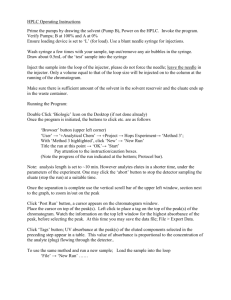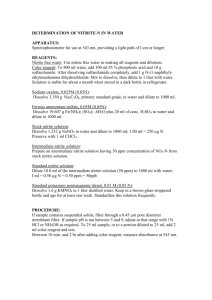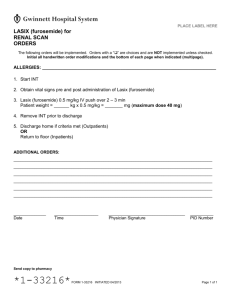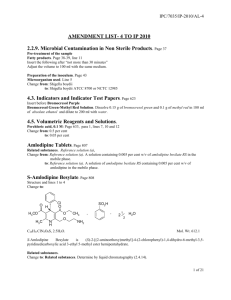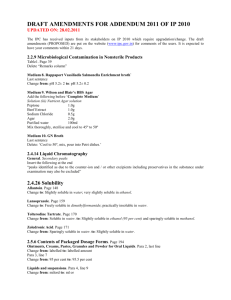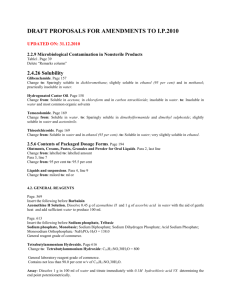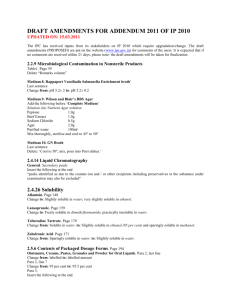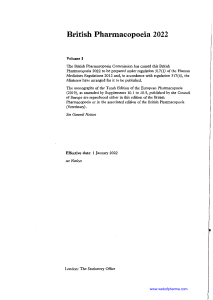FUROSEMIDE (EUROPEAN PHARMACOPOEIA 5.0) Furosemidum
advertisement
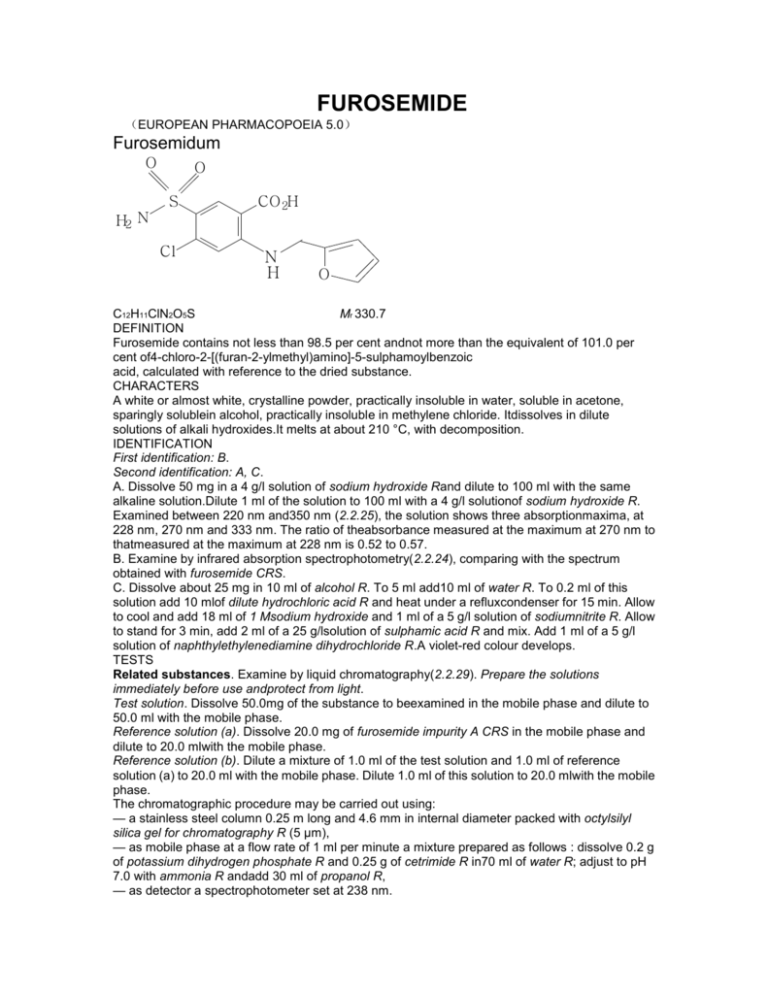
FUROSEMIDE (EUROPEAN PHARMACOPOEIA 5.0) Furosemidum O O S H2 N Cl CO 2H N H O C12H11ClN2O5S Mr 330.7 DEFINITION Furosemide contains not less than 98.5 per cent andnot more than the equivalent of 101.0 per cent of4-chloro-2-[(furan-2-ylmethyl)amino]-5-sulphamoylbenzoic acid, calculated with reference to the dried substance. CHARACTERS A white or almost white, crystalline powder, practically insoluble in water, soluble in acetone, sparingly solublein alcohol, practically insoluble in methylene chloride. Itdissolves in dilute solutions of alkali hydroxides.It melts at about 210 °C, with decomposition. IDENTIFICATION First identification: B. Second identification: A, C. A. Dissolve 50 mg in a 4 g/l solution of sodium hydroxide Rand dilute to 100 ml with the same alkaline solution.Dilute 1 ml of the solution to 100 ml with a 4 g/l solutionof sodium hydroxide R. Examined between 220 nm and350 nm (2.2.25), the solution shows three absorptionmaxima, at 228 nm, 270 nm and 333 nm. The ratio of theabsorbance measured at the maximum at 270 nm to thatmeasured at the maximum at 228 nm is 0.52 to 0.57. B. Examine by infrared absorption spectrophotometry(2.2.24), comparing with the spectrum obtained with furosemide CRS. C. Dissolve about 25 mg in 10 ml of alcohol R. To 5 ml add10 ml of water R. To 0.2 ml of this solution add 10 mlof dilute hydrochloric acid R and heat under a refluxcondenser for 15 min. Allow to cool and add 18 ml of 1 Msodium hydroxide and 1 ml of a 5 g/l solution of sodiumnitrite R. Allow to stand for 3 min, add 2 ml of a 25 g/lsolution of sulphamic acid R and mix. Add 1 ml of a 5 g/l solution of naphthylethylenediamine dihydrochloride R.A violet-red colour develops. TESTS Related substances. Examine by liquid chromatography(2.2.29). Prepare the solutions immediately before use andprotect from light. Test solution. Dissolve 50.0mg of the substance to beexamined in the mobile phase and dilute to 50.0 ml with the mobile phase. Reference solution (a). Dissolve 20.0 mg of furosemide impurity A CRS in the mobile phase and dilute to 20.0 mlwith the mobile phase. Reference solution (b). Dilute a mixture of 1.0 ml of the test solution and 1.0 ml of reference solution (a) to 20.0 ml with the mobile phase. Dilute 1.0 ml of this solution to 20.0 mlwith the mobile phase. The chromatographic procedure may be carried out using: — a stainless steel column 0.25 m long and 4.6 mm in internal diameter packed with octylsilyl silica gel for chromatography R (5 μm), — as mobile phase at a flow rate of 1 ml per minute a mixture prepared as follows : dissolve 0.2 g of potassium dihydrogen phosphate R and 0.25 g of cetrimide R in70 ml of water R; adjust to pH 7.0 with ammonia R andadd 30 ml of propanol R, — as detector a spectrophotometer set at 238 nm. Inject 20 μl of reference solution (b). Adjust the sensitivity of the system so that the heights of the two peaks in the chromatogram obtained are not less than 20 per cent of the full scale of the recorder. The test is not valid unless the resolution between the first peak (furosemide impurity A) and the second peak (furosemide) is at least 4. Inject 20 μl of the test solution. Continue the chromatography for three times the retention time of the principal peak. In the chromatogram obtained with the test solution : the area of any peak, apart from the principal peak, is not greater than the area of the first peak in the chromatogram obtained with reference solution (b) (0.25 per cent) ; the sum of the areas of all the peaks, apart from the principal peak,is not greater than twice the area of the first peak in the chromatogram obtained with reference solution (b) (0.5 percent). Disregard any peak with an area less than 0.1 times the area of the first peak in the chromatogram obtained with reference solution (b). Chlorides (2.4.4). To 0.5 g add a mixture of 0.2 ml of nitric acid R and 30 ml of water R and shake for 5 min. Allow to stand for 15 min and filter. 15 ml of the filtrate complies with the limit test for chlorides (200 ppm). Sulphates (2.4.13). To 1.0 g add a mixture of 0.2 ml of acetic acid R and 30 ml of distilled water R and shake for 5 min.Allow to stand for 15 min and filter. 15 ml of the filtrate complies with the limit test for sulphates (300 ppm). Heavy metals (2.4.8). 1.0 g complies with limit test C for heavy metals (20 ppm). Prepare the standard using 2 ml of lead standard solution (10 ppm Pb) R. Loss on drying (2.2.32). Not more than 0.5 per cent,determined on 1.000 g by drying in an oven at 100 °C to105 °C. Sulphated ash (2.4.14). Not more than 0.1 per cent,determined on 1.0 g. ASSAY Dissolve 0.250 g in 20 ml of dimethylformamide R. Titrate with 0.1 M sodium hydroxide using 0.2 ml of bromothymol blue solution R2. Carry out a blank titration.1 ml of 0.1 M sodium hydroxide is equivalent to 33.07 mg of C12H11ClN2O5S. STORAGE Store protected from light.

